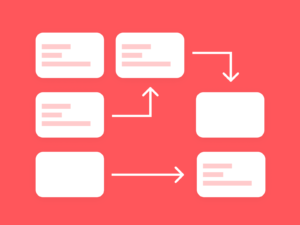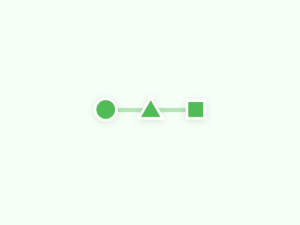This article is a crash course on journey mapping. Customer journey maps are a common tool for user experience design. They are typically used to show the progress of someone through a website or app by showing the steps they would take to complete a set of tasks e.g., the steps someone takes to complete a purchase. They are typically used to identify pain points, areas that are underperforming, or areas that the business wants to improve.
Journey maps are typically used in user experience design or for tracking the conversion paths of customers. You can use them to show the progress of someone through a website or app, the steps someone takes to complete a purchase or the steps someone takes to complete a process.
To create a customer journey map, you first need to identify your product or service and the types of journeys that people will complete. Then, identify the steps that someone must take to complete each journey.
Table of Contents
Definition of a Journey Mapping
A journey map is a visual representation of the steps someone takes to complete a particular process. It can also be referred to as a customer journey map, journey map, or customer experience map. Journey mapping is the activity of making a journey map.


Key Components of a Journey Map
A journey map will typically include the following six components:
1. Actor
The actor is the person or role that the journey map is focused on. It can represent a specific individual, a team, or a company. The actor should be identified at the start of the process.
2. Scenario and Expectations
The scenario is the specific situation of the journey. It includes what the person will be trying to achieve and what they hope to achieve. The expectations are the outcomes of the scenario. They include both positive expectations and negative expectations.
3. Journey Stages
The journey stages are the main steps someone would take to complete their scenario. They are the steps that the actor will go through to achieve their expectations.
4. Actions, Mindsets, and Emotions
Actions are the specific steps that someone would take for each stage. They are the actions that the actor will take to achieve their expectations. The mindsets are the thoughts and feelings the actor will have when completing each stage. They describe the emotions the actor will have when using the product or service.
5. Outcomes
The outcomes are the likely or expected outcomes of the scenario. They are the things that the actor will get or gain from completing their journey.
6. Opportunities
Opportunities are the areas that the business can improve in order to increase the customer’s satisfaction and likelihood to purchase again. This refers to the insights gained from creating the journey map. It could also include areas that are already performing well.
Some Comparisons
It’s important to note the following comparisons to understand journey mapping better:
Journey Map vs. Experience Map
A journey map and an experience map can appear to be very similar. But they are significantly different.
A journey map is focused on a specific user and how they complete a process. An experience map is focused on an entire audience and how they interact with a product or service.
To create a user experience map, you focus on a particular group of people and their interactions with a product or service. These people could be a specific type of customer, a demographic, or a specific type of user.
You would create a user experience map to provide a snapshot of the entire customer journey. It would include all of the steps people take to complete a purchase or to use a product or service. It would also include the emotions, mindsets, and actions of the people involved.
A journey map focuses on a specific customer’s experience with a product or service. It shows the steps they take to complete a process. It will include the actions they take, the emotions they experience, and the outcomes at the end of the process.
Journey Map vs. Service Blueprint
A journey map is similar to a service blueprint. The main difference is that a service blueprint is focused on the service. It typically shows the service provider’s process for serving customers. A customer journey map doesn’t show the service provider’s process. Instead, it focuses on the customer’s experience.
A service blueprint is focused on the service itself. The focus is on how the service provider interacts with the customer. It’s what the service provider does for the customer. A customer journey map is focused on the customer’s experience. It’s what the customer does.
Journey Map vs. User Story Map
A journey map is different from a user story map. A user story map is used to manage a project (e.g. in the Agile process). It describes a feature from a user’s perspective. It shows the user’s goals and how the feature will be used to help them fulfil those goals.
A user story map focuses on a particular feature or functionality and the user’s goals and motivations. A user story map typically describes a feature from a user’s perspective. It describes how a user will use a feature and what the user will get out of it.
A journey map focuses on a customer and their whole experience. It shows the steps they take to complete a process. A journey map describes the emotions, mindsets, and actions they experience. It describes what they will get out of the experience.
Why Use a Journey Map?
Journey mapping reveals how people will complete a process. They are used for showing their mindset, actions, emotions, and any pain points they experience.
They can be used to:
1. Show the steps someone will take to complete a process
2. Show the actions and emotions of a specific person
3. Show how someone will complete a process or journey
4. Show where someone will get stuck or where they will get confused
5. Show the pain points and frustrations people experience
6. Show the emotions, mindset, and actions of an actor
7. Show the outcomes and results of a scenario
8. Show opportunities for improvement or ways to increase satisfaction
When to Use a Customer Journey Map?
We have established that journey mapping is a useful tool. You should create a customer journey map when you want to show the steps someone will take to complete a process. It can also be used when you want to describe the actions someone will take, the emotions they will experience, and the outcomes they will get.
You should also use a customer journey map if you want to identify areas that need to be improved. It’s a great way to find areas that are causing frustration or pain points for your customers.
Tips for Creating Journey Maps
Here are some tips for creating journey maps:
1. Create a Story
A journey map should be a story. It should contain a beginning, middle, and end. The beginning of the journey map should identify the customer and their goals. The middle should describe the steps they will take to get what they want. The end should describe the results they get or the outcomes they achieve.
2. Use Personas
Personas help you think about the people you are designing for. They help you understand their motivations and how they will use your product or service.
3. Identify Actions and Emotions
You should identify actions and emotions that the actor will experience. These are the things the actor will do and the emotions they will have. Think about the actions they will take and the emotions they will have when using the product. Also, think about the actions they will take when completing their journey.
4. Identify Pain Points
Pain points are areas that are frustrating or annoying for someone. They are areas that the business should improve to increase the value of the product or service.
5. Describe the Outcomes
Describe the outcomes someone will get when they complete their journey. Think about the things the person will get or gain when they complete a process.
6. Use the Right Tool
There are many different tools you can use to create a customer journey map. You can use a whiteboard, paper, or an online tool.
7. Include the Emotions
Emotions are an important part of a customer journey map. They are an important part of the customer’s experience. They are an important part of what a person will experience when using a product or service.
Journey Mapping Templates
Here are some templates you can use for journey mapping:
1. Day in the life customer journey mapping template
Source: HubSpot


2. Current state customer journey map template
Source: Bright Vessel


3. Simple customer journey mapping PDF template
Source: Nielsen Norman Group






